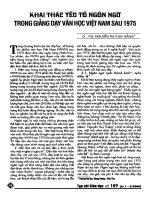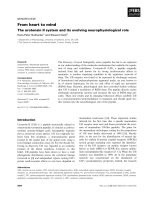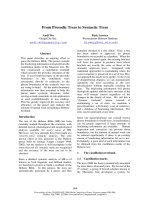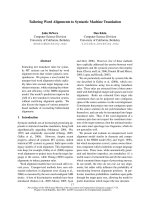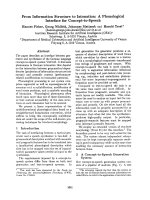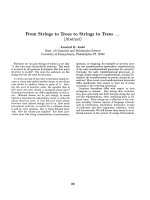Báo cáo khoa học: "From Prosodic Trees to Syntactic Trees" doc
Bạn đang xem bản rút gọn của tài liệu. Xem và tải ngay bản đầy đủ của tài liệu tại đây (193.25 KB, 7 trang )
Proceedings of the COLING/ACL 2006 Main Conference Poster Sessions, pages 898–904,
Sydney, July 2006.
c
2006 Association for Computational Linguistics
From Prosodic Trees to Syntactic Trees
Andi Wu
GrapeCity Inc.
Kirk Lowery
Westminster Hebrew Institute
Abstract
This paper describes an ongoing effort to
parse the Hebrew Bible. The parser consults
the bracketing information extracted from the
cantillation marks of the Masoetic text. We
first constructed a cantillation treebank
which encodes the prosodic structures of the
text. It was found that many of the prosodic
boundaries in the cantillation trees
correspond, directly or indirectly, to the
phrase boundaries of the syntactic trees we
are trying to build. All the useful boundary
information was then extracted to help the
parser make syntactic decisions, either
serving as hard constraints in rule application
or used probabilistically in tree ranking.
This has greatly improved the accuracy and
efficiency of the parser and reduced the
amount of manual work in building a Hebrew
treebank.
Introduction
The text of the Hebrew Bible (HB) has been
carefully studied throughout the centuries, with
detailed lexical, phonological and morphological
analysis available for every verse of HB.
However, very few attempts have been made at a
verse-by-verse syntactic analysis. The only
known effort in this direction is the Hebrew
parser built by George Yaeger (Yaeger 1998,
2002), but the analysis is still incomplete in the
sense that not all syntactic units are recognized
and the accuracy of the trees are yet to be
checked.
Since a detailed syntactic analysis of HB is of
interest to both linguistic and biblical studies,
we launched a project to build a treebank of the
Hebrew Bible. In this project, the trees are
automatically generated by a parser and then
manually checked in a tree editor. Once a tree
has been edited or approved, its phrase
boundaries are recorded in a database. When the
same verse is parsed again, the existing brackets
will force the parser to produce trees whose
brackets are exactly the same as those of the
manually approved trees. Compared with
traditional approaches to treebanking where the
correct structure is preserved in a set of tree files,
our approach has much more agility. In the event
of design/format changes, we can automatically
regenerate the trees according to the new
specifications without manually touching the
trees. The bracketing information will persist
through the updates and the basic structure of the
trees will remain correct regardless of the
changes in the details of trees. We call this a
“dynamic treebank” where, instead of
maintaining a set of trees, we maintain a
parser/grammar, a dictionary, a set of sentences,
and a database of bracketing information. The
trees can be generated at any time.
Since our parser/grammar can consult known
phrase boundaries to build trees, its performance
can be greatly improved if large amounts of
bracketing information are available. Human
inspection and correction can provide those
boundaries, but the amount of manual work can
be reduced significantly if there is an existing
source of bracketing information for us to use.
Fortunately, a great deal of such information can
be obtained from the cantillation marks of the
Hebrew text.
1 The cantillation treebank
1.1 Cantillation marks
The text of HB has been systematically annotated
for more than a thousand years. By the end of the
9
th
century, a group of Jewish scholars known as
the Masoretes had developed a system for
898
marking the structures of the Bible verses. The
system contains a set of cantillation marks
1
which indicate the division and subdivision of
each verse, very much like the punctuation marks
or the brackets we use to mark constituent
structures. At that time, those cantillation marks
were intended to record the correct way of
reading or chanting the Hebrew text: how to
group words into phrases and where to put pauses
between intonational units. In the eyes of modern
linguists, the hierarchical structures thus marked
can be best understood as a prosodic
representation of the verses (Dresher 1994).
There are two types of cantillation marks: the
conjunctive marks which group multiple words
into single units and the disjunctive marks which
divide and subdivide a verse in a binary fashion.
The marking of Genesis 1:1, for example, is
equivalent to the bracketing shown below.
(English words are used here in place of Hebrew
to make it easier for non-Hebrew-speakers to
understand. OM stands for object marker.)
( ( ( In beginning )
( created God )
)
( ( OM
( the heavens )
)
( ( and OM )
( the earth )
)
)
)
This analysis resembles the prosodic structure in
Selkirk (1984) and the performance structure in
Gee and Grosjean (1983).
1.2. Parsing the prosodic structure
The cantillation system in the Mesoretic text is a
very complex one with dozens of diacritic
symbols and complicated annotation rules. As a
result, only a few trained scholars can decipher
them and their practical use has been very limited.
In order to make the information encoded by this
system more accessible to both humans and
1
The cantillation marks show how a text is to be sung.
See />.
machines, we built a treebank where the prosodic
structures of HB verses are explicitly represented
as trees in XML format (Wu & Lowery, 2006).
There have been quite a few studies of the
Masoretic cantillation system. After reviewing
the existing analyses, such as Wickes (1881),
Price (1990), Richter (2004) and Jacobson (2002),
we adopted the binary analysis of British and
Foreign Bible Society (BFBS 2002) which is
based on the principle of dichotomy of Wicks
(1881). The binary trees thus generated are best
for extracting brackets that are syntactically
significant.
We found all the binary rules that underlie the
annotation and coded them in a context-free
grammar. This CFG was then used by the parser
to automatically generate the prosodic trees. The
input text to the parser was the MORPH database
developed by Groves & Lowery (2006) where the
the cantillation marks are represented as numbers
in its Michigan Code text.
The following is the prosodic tree generated for
Genesis 1:1, displayed in English glosses in the
tree editor (going right-to-left according to the
writing convention of Hebrew):
Figure 1
The node labels “athnach”, “tiphcha”, “mereka”
and “munach” in this tree are names of the
cantillation marks that indicate the types of
boundaries between the two chunks they
dominate. Different types of boundaries have
different (relative) boundary strengths. The “m”
nodes are morphemes and the “w” nodes are
words.
899
1.3. A complete prosodic treebank
Since the Mesoretic annotation is supposed to
mark the structure of every verse unambiguously,
we expect to parse every verse successfully with
exactly one tree assigned to it, given that (1) the
annotation is perfectly correct and (2) the CFG
grammars correctly encoded the annotation rules.
The actual results were close to our expectation:
all the 23213 verses were successfully parsed, of
which 23099 received exactly one complete tree.
The success rate is 99.5 percent. The 174 verses
that received multiple parse trees all have words
that carry more than one cantillation mark. This
can of course create boundary ambiguities and
result in multiple parse trees. We have good
reasons to believe that the grammars we used are
correct. We would have failed to parse some
verses if the grammars had been incomplete and
we would have gotten multiple trees for a much
greater number of verses if the grammars had
been ambiguous.
2 Phrase boundary extraction
Now that a cantillation treebank is available, we
can get brackets from those trees and use them in
syntactic parsing. Although prosodic structures
are not syntactic structures, they do correspond to
each other in some systematic ways. Just as there
are ways to transform syntactic structures to
prosodic structures (e.g. Abney 1992), prosodic
structures can also provide clues to syntactic
structures. As we have discovered, some of the
brackets in the cantillation trees can be directly
mapped to syntactic boundaries, some can be
mapped after some adjustment, and some have no
syntactic significance at all.
2.1 Direct correspondences
Direct correspondences are most likely to be
found at the clausal level. Almost all the clause
boundaries can be found in the cantillation trees.
Take Genesis 1:3 as an example:
Figure 2
Here, the verse is first divided into two clauses:
“God said let there be light” and “there was light”.
The first clause is further divided into “God said”
and “let there be light”. Such bracketing will
prevent the wrong analysis where “let there be
light” and “there was light” are conjoined to
serve as the object of “God said”. Given the fact
that there are no punctuation marks in HB, it is
very difficult for the parser to rule out the wrong
parse without the help of the cantillatioin
information.
Coordination is another area where the
cantillation brackets are of great help. The
syntactic ambiguity associated with coordination
is well-known, but the ambiguity can often be
resolved with help of prosodic cues. This is
indeed what we find in the cantillation treebank.
In Genesis 24:35, for example, we find the
following sequence of words: “male servants and
maid servants and camels and donkeys”.
Common sense tells us that there are only two
possible analyses for this sequence: (1) a flat
structure where the four NPs are sisters, or (2)
“male servant” conjoins with “maid servant,
“camels” conjoins with “donkeys”, and then the
two conjoined NPs are further conjoined as
sisters. However, the computer is faced with 14
different choices. Fortunately, the cantillation
tree can help us pick the correct structure:
900
Figure 3
The brackets extracted from this tree will force
the parser to produce only the second analysis
above.
Good correspondences are also found for most
base NPs and PPs. Here is an example from
Genesis 1:4, which means “God separated the
light from the darkness”:
Figure 4
As we can see, the noun phrases and
prepositional phrases all have corresponding
brackets in this tree.
2.2 Indirect correspondences
Now we turn to prosodic structures that can be
adjusted to correspond to syntactic structures.
They usually involve the use of function words
such as conjunctions, prepositions and
determiners. Syntactically, these words are
supposed to be attached to complete NPs, often
resulting in trees where those single words are
sisters to large NP chunks. Such “unbalanced”
trees are rarely found in prosodic structures,
however, where a sentence tends to be divided
into chunks of similar length for better rhythm
and flow of speech.
This is certainly the case in the HB cantillation
treebank. It must have already been noticed in
the example trees we have seen so far that the
conjunction “and” is always attached to the word
that immediately follows it. As a matter of fact,
the conjunction and the following word are often
treated as a single word for phonological reasons.
Prepositions are also traditionally treated as part
of the following word. It is therefore not a
surprise to find trees of the following kind:
Figure 5
In this tree, the preposition “over” is attached to
“surface of” instead of “surface of the waters”.
We also see the conjunction “and” is attached to
“spirit of” rather than to the whole clause.
A similar situation is found for determiners, as
can be seen in this sub-tree where “every of” is
attached to “crawler of” instead of “crawler of the
ground”.
Figure 6
901
In all these cases, the differences between
prosodic structures and syntactic structures are
systematic and predictable. All of them can be
adjusted to correspond better to syntactic
structures by raising the function words out of
their current positions and re-attach them to some
higher nodes.
2.3 Extracting the boundaries
In the bracket extraction phase, we go through all
the sub-trees and get their beginning and ending
positions in the form of (begin, end). Given the
tree in Figure 6, for example, we can extract the
following brackets: (n, n+3), (n, n+1), (n+2,
n+3), where n is the position of the first word in
the sub-tree.
For cases of indirect correspondence discussed in
2.2, we automatically adjust the brackets by
removing the ones around the function word and
its following word and adding a pair of brackets
that start from the word following the function
word and end in the last word of the phrase. After
this adjustment, the brackets extracted from
Figure 6 will become (n, n+3), (n+1, n+3) and
(n+2, n+3). This in effect transforms this tree to
the one in Figure 7 which corresponds better to its
syntactic structure:
Figure 7
For trees that start with “and”, we detach “and”
and re-attach it to the highest node that covers the
phrase starting with “and”. After this and other
adjustments, the brackets we extract from Figure
5 will be:
(n, n+7)
(n+1, n+7)
(n+1, n+2)
(n+3, n+7)
(n+4, n+7)
(n+5, n+7)
(n+6, n+7)
These brackets transform the tree into the one in
Figure 8:
Figure 8
The cantillation trees also contain brackets that
are not related to syntactic structures at all. Since
it is difficult to identify those useless brackets
automatically, we just leave them alone and let
them be extracted anyway. Fortunately, as we
will see in the next section, the parser does not
depend completely on the extracted bracketing
information. The useless brackets can simply be
ignored in the parsing process.
3 Building a syntactic treebank
As we mentioned earlier, we use a parser to
generate the treebank. This parser uses an
augmented context-free grammar that encodes
the grammatical knowledge of Biblical Hebrew.
Each rule in this grammar has a number of
grammatical conditions which must be satisfied
in order for the rule to apply. In addition, it may
have a bracketing condition which can either
block the application of a rule or force a rule to
apply.
Besides serving as conditions in rule application,
902
the bracketing information is also used to rank
trees in cases where more than one tree is
generated.
3.1 Brackets as rule conditions
Bracketing information is used in some grammar
rules to guide the parser in making syntactic
decisions. In those rules, we have conditions that
look at the beginning position and ending
position of the sub-tree to be produced by the rule
and check to see if those bracket positions are
found in our phrase boundary database. The
sub-tree will be built only if the bracketing
conditions are satisfied.
There are two types of bracketing conditions.
One type serves as the necessary and sufficient
condition for rule application. These conditions
work in disjunction with grammatical conditions.
A rule will apply when either the grammatical
conditions or the bracketing conditions are
satisfied. This is where the bracketing condition
can force a rule to apply regardless of the
grammatical conditions. The brackets consulted
by this kind of conditions must be the manually
approved ones or the automatically extracted
ones that are highly reliable. Such conditions
make it possible for us to override grammatical
conditions that are too strict and build the
structures that are known to be correct.
The other type of bracketing conditions serves as
the necessary conditions only. They work in
conjunction with grammatical conditions to
determine the applicability of a rule. The main
function of those bracketing conditions is to
block structures that the grammatical conditions
fail to block because of lack of information.
However, they cannot force a rule to apply. The
sub-tree to be produced the rule will be built only
if both the grammatical conditions and the
bracketing conditions are met.
The overall design of the rules and conditions are
meant to build a linguistically motivated Hebrew
grammar that is independent of the cantillation
treebank while making use of its prosodic
information.
3.2 Brackets for tree ranking
The use of bracketing conditions greatly reduces
the number of trees the parser generates. In fact,
many verses yield a single parse only. However,
there are still cases where multiple trees are
generated. In those cases, we use the bracketing
information to help rank the trees.
During tree ranking, the brackets of each tree are
compared with the brackets in the cantillation
trees to find the number of mismatches. Trees
that have fewer mismatches are ranked higher
than trees that have more mismatches. In most
cases, the top-ranking tree is the correct parse.
Theoretically, it should be possible to remove all
the bracketing conditions from the rules, let the
parser produce all possible trees, and use the
bracketing information solely at the tree-ranking
stage to select the correct trees. We can even use
machine learning techniques to build a statistical
parser. However, a Treebank of the Bible
requires 100% accuracy but none of the statistical
models are capable of that standard yet. As long
as 100% accuracy is not guaranteed, manual
checking will be required to fix all the individual
errors. Such case-by-case fixes are easy to do in
our current approach but are very difficult in
statistical models.
3.3 Evaluation
Since only a very small fraction of the trees
generated by our parser have been manually
verified, there is not yet a complete golden
standard to objectively evaluate the accuracy of
the parser. However, some observations are
obvious:
(1) The parsing process can become intractable
without the bracketing conditions. We tried
parsing with those conditions removed from
the rules to see how many more trees we will
get. It turned out that parsing became so slow
that we had to terminate it before it was
finished. This shows that the bracketing
conditions are playing an indispensable role
in making syntactic decisions.
903
(2) The number of edits needed to correct the
trees in manual checking is minimal. Most
trees generated by the machine are basically
correct and only a few touches are necessary
to make them perfect.
(3) The boundary information extracted from the
cantillation tree could take a long time to
create if done by hand, and a great deal of
manual work is saved by using the brackets
from the cantillation treebank.
Conclusion
In this paper, we have demonstrated the use of
prosodic information in syntactic parsing in a
treebanking project. There are correlations
between prosodic structures and syntactic
structures. By using a parser that consults the
prosodic phrase boundaries, the cost of building
the treebank can be minimized.
References
Abney, S (1992) Prosodic Structure, Performance
Structure and Phrase Structure. In Proceedings,
Speech and Natural. Language Workshop, pp.
425-428.
BFBS (2002) The Masoretes and the Punctuation of
Biblical Hebrew. British & Foreign Bible Society,
Machine Assisted Translation Team.
Dresher, B.E. (1994) The Prosodic Basis of the
Tiberian Hebrew System of Accents. In Language,
Vol. 70, No 1, pp. 1-52.
Gee J. P. & F. Grosjean (2002) The Masoretes and
the Punctuation of Biblical Hebrew. British &
Foreign Bible Society, Machine Assisted
Translation Team.
Groves, A & K. Lowery, eds. (2006). The Westminster
Hebrew Bible Morphology Database. Philadelphia:
Westminster Hebrew Institute.
Jacobson, J.R. (2002) Chanting the Hebrew Bible.
The Jewish Publication Society, Philadelphia
Price, J. (1990) The Syntax of Masoretic Accents in
the Hebrew Bible. The Edwin Mellen Press,
Lewiston/Queenston/Lampeter.
Richter, H (2004) Hebrew Cantillation Marks and
Their Encoding. Published at
Selkirk, E. (1984) Phonology and Syntax: The
Relation between Sound and Structure. Cambridge,
MA: MIT Press.
Wickes, W. (1881) Two Treatises on the Accentuation
of the Old Testament. Reprint by KTAV, New
York, 1970
Wu, A & K. Lowery (2006) A Hebrew Tree Bank
Based on Cantillation Marks. In Proceedings of
LREC 2006.
Yaeger, G (1998) Layered Parsing: a Principled
Bottom-up Parsing Formalism for Classical Biblical
Hebrew, a working paper, ASTER Institute, Point
Pleasant, NJ.
Yaeger, G (2002) A Layered Parser Implementation of
a Schema of Clause Types in Classical Biblical
Hebrew, SBL Conference, Toronto, Ontario,
Canada.
904

